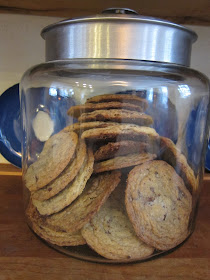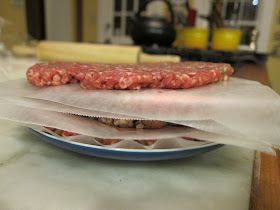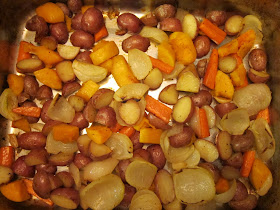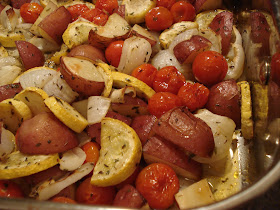
After our last trip to the Napa Valley, I went on a cookbook-buying spree and purchased several Thomas Keller volumes. I am lucky enough to have dined at The French Laundry and at Bouchon and was so excited to learn something from the master who had spawned those restaurants. Though I've not yet eaten at Ad Hoc, Keller's family-style restaurant in Yountville, the idea of it intrigued me enough to also buy Ad Hoc at Home: Family-Style Recipes.

What I appreciate and respect so much about Thomas Keller in all of his books is that he explains everything precisely in the ideal way it should be done. He doesn't include notes about how to take shortcuts. He doesn't suggest that you can create any of the dishes in any of these books in 30 minutes or less. He is saying, if you want to take the time to cook right, I'll tell you how to do it. And he has faith that you can if you just try. Which I love and respect, even as I look at some of the sections of his instructions, and think, yeah, right, I can't/won't do that part. While I've only begun to delve into actually cooking with the three books of his I own, I have loved reading through them all and learning from them.
So when I came across the Ad Hoc recipe for chocolate-chip cookies, which he, Thomas Keller, calls "arguably the best cookie ever," I thought, these must be worth a try.
And I'm so glad I tried them. These cookies are as close to perfect as I've ever had. Chocolate-chip cookies are so common that they mean a million different things to a million different people. I don't know when I last bothered to make any. These are perfectly chewy in the middle and inside, and just a little crispy around the edges. They are completely addicting and delicious. There are several things about them that stood out to me as different from the norm in a chocolate-chip-cookie recipe, which, collectively, I can only assume make all the difference.
First, he calls for cold butter cut into small pieces. I have always, in any recipe for chocolate-chip cookies, or for any cookies for that matter, used softened butter, and have chided myself when my butter didn't seem properly soft enough but I trudged ahead with the cookie making anyway. I have not looked up the science of this (don't tell my husband), but I think the cold butter may be partly responsible for the beautiful texture and body of the finished cookies. Keller has you beat half the butter on medium speed until fairly smooth, then add the sugars and the rest of the butter and beat until it's all well combined. And it works just great. I've made one other variety of cookie since first trying this recipe and I used the same cold-diced-butter technique and I think it paid off.
Second, it calls for one whole teaspoon of salt. That strikes me as more than most recipes. I can taste the difference. You need some salt with your chocolate chips for this most ordinary of sweets to be its most divine. And with seasoning, as with everything else, he is all about doing it exactly right.

Third, he calls for two different chocolates, "one sweeter, one with a more complex bittersweet balance." Okay, sure. Although that wouldn't stop me from making these if I only had one kind of chocolate on hand. But also in regard to the chocolate, he has you chop the chocolate into chip-sized pieces (rather than simply using ready-made "chips"), which just feels like a special touch. It's nice having some especially large chocolate chunks to come across in your cookies, and not having them all be predictably uniform. Keller also directs you to sift the chocolate after you chop it to "remove any tiny fragments to give the cookies a cleaner look." I have skipped this step each time I've made these because I couldn't be bothered to be that fussy and I don't mind my cookies a little "unclean" due to some extra chocolate dust.
Lastly, he taught me that cookies are done when they are no longer shiny. I find this such a useful tidbit and don't know how I hadn't come across it until now. Rather than having my cookies be underdone or overdone, I can cook them pretty perfectly by just checking on this shininess factor after they've had their approximate time in the oven. Very useful.

Chocolate-Chip Cookies
from Ad Hoc at Home, Thomas Keller
2 1/3 C plus 1 T flour
3/4 t baking soda
1 t kosher salt
10 oz. chocolate, cut into chip-sized pieces (Keller recommends 5 oz. 55% chocolate and 5 oz. 70-72% to have one sweeter chocolate and one with "more complex bittersweet balance. I used half Baker's bittersweet and half Baker's semi-sweet.)
2 sticks cold unsalted butter, cut into small pieces
1 C packed dark brown sugar
3/4 C granulated sugar
2 large eggs
Preheat oven to 350.
Stir together flour, baking soda, and salt in a medium bowl.
In the bowl of a stand mixer fitted with paddle attachment, beat half the butter on medium speed until fairly smooth. Add both sugars and remaining butter, and beat until well combined, then beat for a few minutes, until mixture is light and creamy. Scrape down the sides of the bowl. Add the eggs one at a time, beating until the first one is incorporated before adding the next, and scraping the bowl as needed. Add dry ingredients and mix on low speed to combine. Mix in the chocolate.
Dough or shaped cookies can be refrigerated, well-wrapped, for up to 5 days or frozen for up to 2 weeks. Freeze shaped cookies on baking sheets until firm, then transfer to freezer containers. (Defrost frozen cookies overnight in the refrigerator before baking.)
Using about 2 tablespoons per cookie, shape dough into balls. Arrange 8 cookies on each pan, leaving about 2 inches between them. Bake for 12 minutes, or until the tops are no longer shiny, rotating pan halfway through baking.
Cool cookies on pans for about 2 minutes to firm up a bit, then transfer to racks to cool completely. Repeat to bake remaining cookies. Makes about 30 3-inch cookies.


































